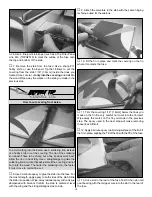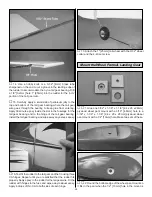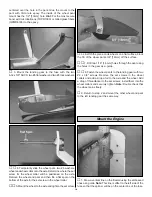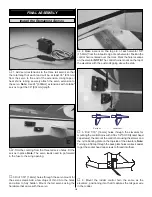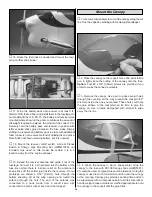
3. I will perform my initial turn after takeoff away from the pit
or spectator areas and I will not thereafter fly over pit or
spectator areas, unless beyond my control.
4. I will operate my model using only radio control frequencies
currently allowed by the Federal Communications Commission.
❏
1. Fuelproof all areas exposed to fuel or exhaust residue
such as the cowl ring, cowl mounting blocks, wing saddle
area, etc.
❏
2. Check the C.G. according to the measurements
provided in the manual.
❏
3. Be certain the battery and receiver are securely
mounted in the fuse. Simply stuffing them into place with
foam rubber is not sufficient.
❏
4. Extend your receiver antenna and make sure it has a
strain relief inside the fuselage to keep tension off the solder
joint inside the receiver.
❏
5. Balance your model
laterally as explained in
the instructions.
❏
6. Use threadlocking compound to secure critical fasteners
such as the set screws that hold the wheel axles to the struts,
screws that hold the carburetor arm (if applicable), screw-lock
pushrod connectors, etc.
❏
7. Add a drop of oil to the axles so the wheels will turn freely.
❏
8. Make sure all hinges are securely glued in place.
❏
9. Reinforce holes for wood screws with thin CA
where appropriate (servo mounting screws, cowl mounting
screws, etc.).
❏
10. Confirm that all controls operate in the correct
direction and the throws are set up according to the manual.
❏
11. Make sure there are silicone retainers on all the
clevises and that all servo arms are secured to the servos
with the screws included with your radio.
❏
12. Secure connections between servo wires and Y-
connectors or servo extensions and the connection between
your battery pack and the on/off switch with vinyl tape, heat
shrink tubing or special clips suitable for that purpose.
❏
13. Make sure any servo extension cords you may have
used do not interfere with other systems (servo arms,
pushrods, etc.).
❏
14. Secure the pressure tap (if used) to the muffler with high
temp RTV silicone, thread locking compound or J.B. Weld.
❏
15. Make sure the fuel lines are connected and are
not kinked.
❏
16. Balance your propeller (and spare propellers).
❏
17. Tighten the propeller nut and spinner.
❏
18. Place your name, address, AMA number and
telephone number on or inside your model.
❏
19. Cycle your receiver battery pack (if necessary) and
make sure it is fully charged.
❏
20. If you wish to photograph your model, do so before
your first flight.
❏
21. Range check your radio when you get to the flying field.
The U-Can-Do 3D .46 ARF is a great-flying model that flies
smoothly and predictably. The U-Can-Do 3D .46 ARF does
not, however, possess the self-recovery characteristics of a
primary R/C trainer and should be flown only by experienced
R/C pilots.
Whether you are looking to practice new 3D maneuvers and
don't want to risk your competition aircraft, or are just
starting to learn the most basic aerobatics, the U-Can-Do
3D .46 ARF is a great choice. Regardless of your skill level,
be sure your first flight begins with low rates (yes, even in a
crosswind) and that you gradually expand your flight, adding
one new maneuver at a time.
Take offs, landings and most of your normal flights should be
flown on low rates. (If your radio does not have dual rates, be
sure to set the model up on the low rates provided.) The high
rates on this model are meant ONLY for use when doing 3D
aerobatics – maneuvers performed while the model is flying
slower than its normal stall speed. That includes maneuvers
as simple as a stall turn, or as complex as harrier rolls.
Don't get spoiled by how incredibly well the U-Can-Do 3D
.46 ARF hangs and torque rolls! Most models take an
enormous amount of work to keep the model stationary in a
hanger, but the unique design of U-Can-Do 3D .46 ARF
helps lock it solid in position and torque roll and hang with
relative ease.
Fuel Mixture Adjustments
A fully cowled engine may run at a higher temperature than
an un-cowled engine. For this reason, the fuel mixture
should be richened so the engine runs at about 200 RPM
below peak speed. By running the engine slightly rich, you
will help prevent dead-stick landings caused by overheating.
FLYING
During the last few moments of preparation your mind
may be elsewhere anticipating the excitement of the first
flight. Because of this, you may be more likely to overlook
certain checks and procedures that should be performed
before the model is flown. To help avoid this, a checklist is
provided to make sure these important areas are not
overlooked. Many are covered in the instruction manual,
so where appropriate, refer to the manual for complete
instructions. Be sure to check the items off as they are
completed (that's why it's called a
check list!).
CHECK LIST
24



